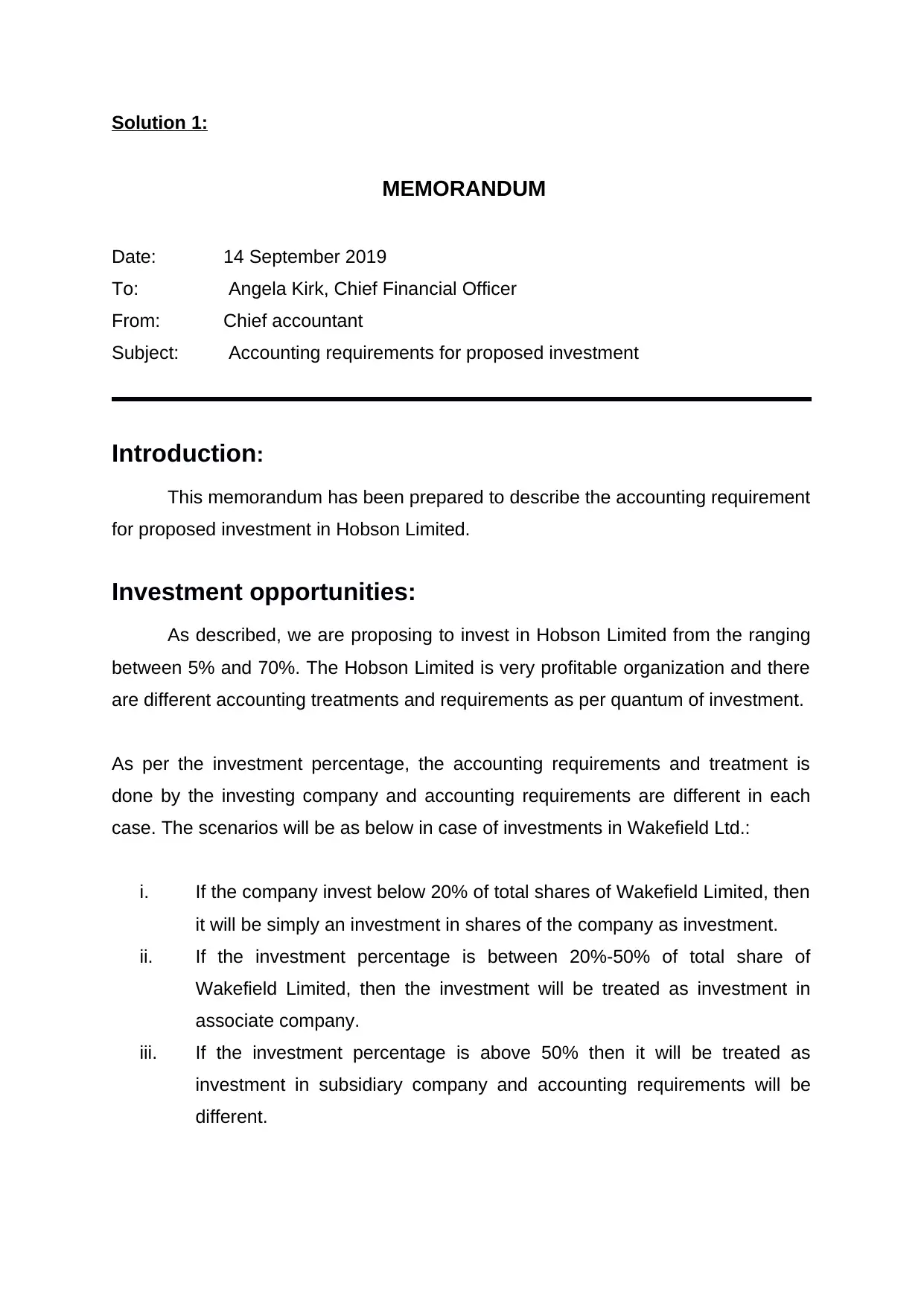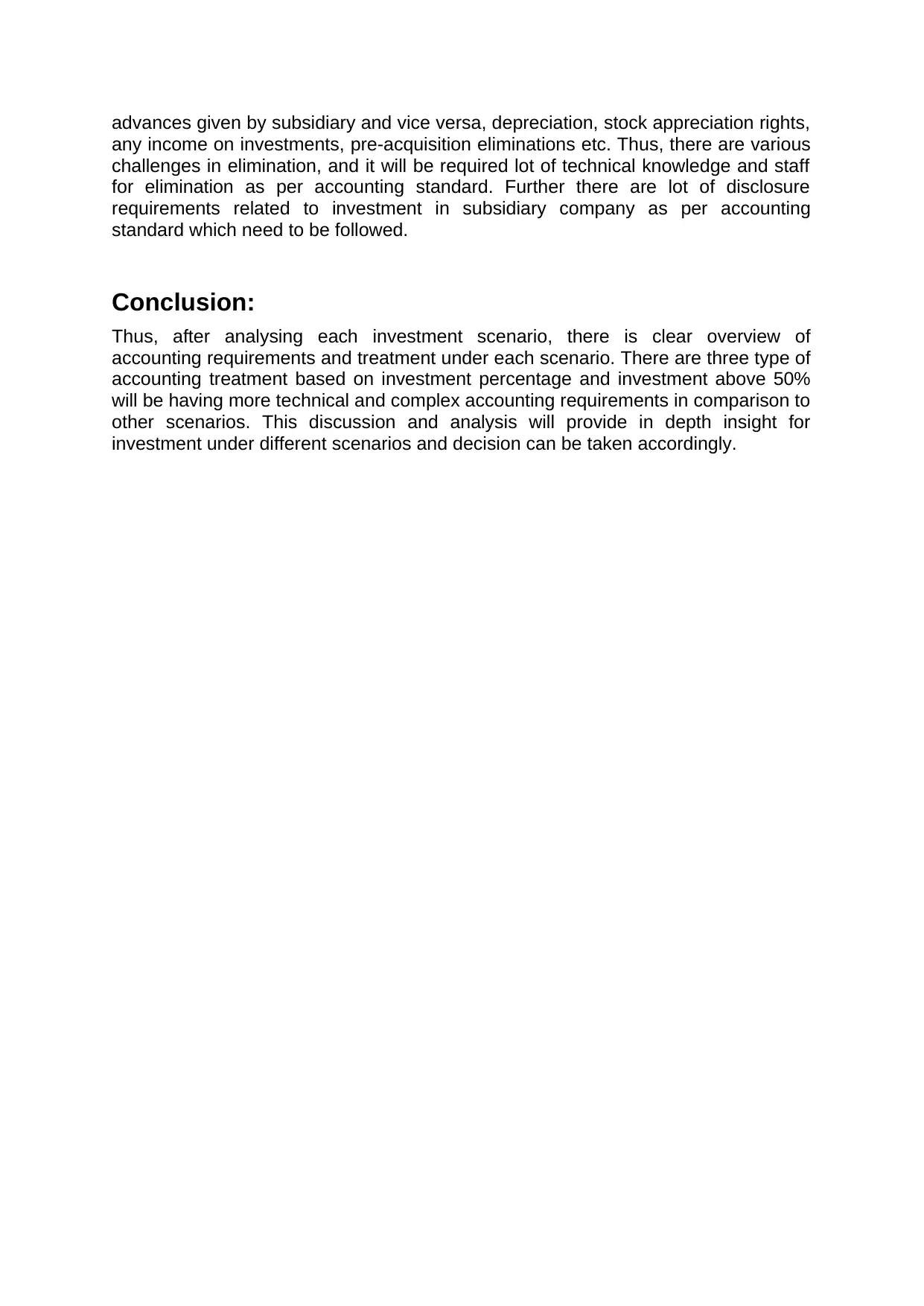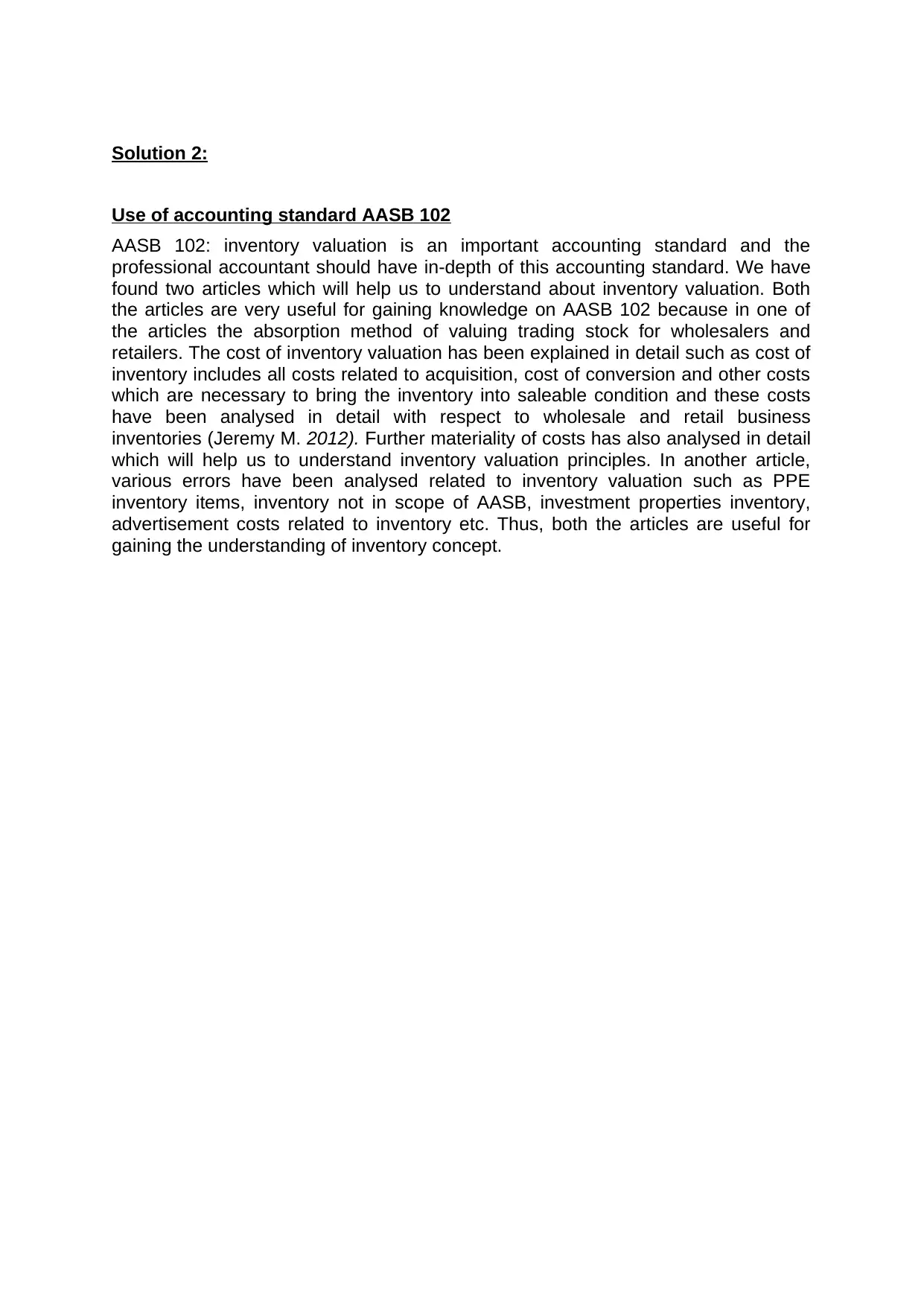Accounting Requirements for Proposed Investment
VerifiedAdded on 2022/12/29
|5
|1346
|87
AI Summary
This memorandum describes the accounting requirements for a proposed investment in Hobson Limited. It covers different scenarios based on the percentage of investment and provides insights into the accounting treatment for each scenario.
Contribute Materials
Your contribution can guide someone’s learning journey. Share your
documents today.

Solution 1:
MEMORANDUM
Date: 14 September 2019
To: Angela Kirk, Chief Financial Officer
From: Chief accountant
Subject: Accounting requirements for proposed investment
Introduction:
This memorandum has been prepared to describe the accounting requirement
for proposed investment in Hobson Limited.
Investment opportunities:
As described, we are proposing to invest in Hobson Limited from the ranging
between 5% and 70%. The Hobson Limited is very profitable organization and there
are different accounting treatments and requirements as per quantum of investment.
As per the investment percentage, the accounting requirements and treatment is
done by the investing company and accounting requirements are different in each
case. The scenarios will be as below in case of investments in Wakefield Ltd.:
i. If the company invest below 20% of total shares of Wakefield Limited, then
it will be simply an investment in shares of the company as investment.
ii. If the investment percentage is between 20%-50% of total share of
Wakefield Limited, then the investment will be treated as investment in
associate company.
iii. If the investment percentage is above 50% then it will be treated as
investment in subsidiary company and accounting requirements will be
different.
MEMORANDUM
Date: 14 September 2019
To: Angela Kirk, Chief Financial Officer
From: Chief accountant
Subject: Accounting requirements for proposed investment
Introduction:
This memorandum has been prepared to describe the accounting requirement
for proposed investment in Hobson Limited.
Investment opportunities:
As described, we are proposing to invest in Hobson Limited from the ranging
between 5% and 70%. The Hobson Limited is very profitable organization and there
are different accounting treatments and requirements as per quantum of investment.
As per the investment percentage, the accounting requirements and treatment is
done by the investing company and accounting requirements are different in each
case. The scenarios will be as below in case of investments in Wakefield Ltd.:
i. If the company invest below 20% of total shares of Wakefield Limited, then
it will be simply an investment in shares of the company as investment.
ii. If the investment percentage is between 20%-50% of total share of
Wakefield Limited, then the investment will be treated as investment in
associate company.
iii. If the investment percentage is above 50% then it will be treated as
investment in subsidiary company and accounting requirements will be
different.
Secure Best Marks with AI Grader
Need help grading? Try our AI Grader for instant feedback on your assignments.

Accounting requirements for investment below 20%
Under this scenario, if the investment in shares of Wakefield is made below 20%
then it is a simple investment in shares, and it will be treated as non-current
investment. The investment is recorded at fair value in balance sheet under non-
current other financial assets as investment in securities. The dividend income on
investment is recognized in income statement and gain/loss on sale of securities is
also recognized in income statement. There are no other specific accounting
requirements for investment in shares of an entity.
Accounting requirements for investment between 20%-50%
If we are planning to invest in the Wakefield Limited between 20%-50%, then it will
be treated as investment in associates because the significant influence will be
established as per accounting standard and we can exercise significant influence
through voting rights. The equity method is used for accounting of investment in
associates. The investment in associates is recorded at original costs. The
investment is increases based on pro rata share of investee’s income and decreases
on pro rata basis investee’s share in dividend distributed by the investee company.
The company has also to record the goodwill if arise at the time of investment due to
difference in cost of investment less book value of assets (AASB 2018). There is
only one line-item consolidation in income statement and balance sheet. Further
investing entity has to disclose the various accounting information in annual report
such as name of associate company, percentage hold, transaction with associates
such as sale or purchase, investment, dividend or any other transactions. The
investor has also need to adjust for upstream and downstream, unrealized profit/
losses, proportionate share of profit/ loss etc. AASB 128 will be followed for
accounting treatment/ requirements.
Accounting requirements for investment above 50%
If we are planning to invest above 50% in Wakefield Limited, then it will be treated as
investment in Subsidiary company because we will be having the control over the
investing entity and we can take decisions of the company. Under this scenario, we
can impact the returns of the entity through casting our voting powers. Accounting
requirements for subsidiary is one of the toughest challenges and there are lot of
technical requirements for consolidation of a subsidiary company. Under the
subsidiary investment, each line is consolidated, and eliminations are done for inter
group transactions and finally minority investment is calculated for shareholders
other than our company.
In consolidation of accounts of subsidiary company each line item of income
statement and balance sheet will be consolidated along with our financial
statements. After each line item consolidation, inter group transaction will be
eliminated. The elimination is one of the biggest challenges in accounting
requirement. For example, any sale or purchase between the companies have to
eliminate for each transaction, management fee income charged, calculation of profit
margin charged by either company, foreign currency translation issues, any
investment made in plant, property and equipment, goodwill elimination, loan and
Under this scenario, if the investment in shares of Wakefield is made below 20%
then it is a simple investment in shares, and it will be treated as non-current
investment. The investment is recorded at fair value in balance sheet under non-
current other financial assets as investment in securities. The dividend income on
investment is recognized in income statement and gain/loss on sale of securities is
also recognized in income statement. There are no other specific accounting
requirements for investment in shares of an entity.
Accounting requirements for investment between 20%-50%
If we are planning to invest in the Wakefield Limited between 20%-50%, then it will
be treated as investment in associates because the significant influence will be
established as per accounting standard and we can exercise significant influence
through voting rights. The equity method is used for accounting of investment in
associates. The investment in associates is recorded at original costs. The
investment is increases based on pro rata share of investee’s income and decreases
on pro rata basis investee’s share in dividend distributed by the investee company.
The company has also to record the goodwill if arise at the time of investment due to
difference in cost of investment less book value of assets (AASB 2018). There is
only one line-item consolidation in income statement and balance sheet. Further
investing entity has to disclose the various accounting information in annual report
such as name of associate company, percentage hold, transaction with associates
such as sale or purchase, investment, dividend or any other transactions. The
investor has also need to adjust for upstream and downstream, unrealized profit/
losses, proportionate share of profit/ loss etc. AASB 128 will be followed for
accounting treatment/ requirements.
Accounting requirements for investment above 50%
If we are planning to invest above 50% in Wakefield Limited, then it will be treated as
investment in Subsidiary company because we will be having the control over the
investing entity and we can take decisions of the company. Under this scenario, we
can impact the returns of the entity through casting our voting powers. Accounting
requirements for subsidiary is one of the toughest challenges and there are lot of
technical requirements for consolidation of a subsidiary company. Under the
subsidiary investment, each line is consolidated, and eliminations are done for inter
group transactions and finally minority investment is calculated for shareholders
other than our company.
In consolidation of accounts of subsidiary company each line item of income
statement and balance sheet will be consolidated along with our financial
statements. After each line item consolidation, inter group transaction will be
eliminated. The elimination is one of the biggest challenges in accounting
requirement. For example, any sale or purchase between the companies have to
eliminate for each transaction, management fee income charged, calculation of profit
margin charged by either company, foreign currency translation issues, any
investment made in plant, property and equipment, goodwill elimination, loan and

advances given by subsidiary and vice versa, depreciation, stock appreciation rights,
any income on investments, pre-acquisition eliminations etc. Thus, there are various
challenges in elimination, and it will be required lot of technical knowledge and staff
for elimination as per accounting standard. Further there are lot of disclosure
requirements related to investment in subsidiary company as per accounting
standard which need to be followed.
Conclusion:
Thus, after analysing each investment scenario, there is clear overview of
accounting requirements and treatment under each scenario. There are three type of
accounting treatment based on investment percentage and investment above 50%
will be having more technical and complex accounting requirements in comparison to
other scenarios. This discussion and analysis will provide in depth insight for
investment under different scenarios and decision can be taken accordingly.
any income on investments, pre-acquisition eliminations etc. Thus, there are various
challenges in elimination, and it will be required lot of technical knowledge and staff
for elimination as per accounting standard. Further there are lot of disclosure
requirements related to investment in subsidiary company as per accounting
standard which need to be followed.
Conclusion:
Thus, after analysing each investment scenario, there is clear overview of
accounting requirements and treatment under each scenario. There are three type of
accounting treatment based on investment percentage and investment above 50%
will be having more technical and complex accounting requirements in comparison to
other scenarios. This discussion and analysis will provide in depth insight for
investment under different scenarios and decision can be taken accordingly.

Solution 2:
Use of accounting standard AASB 102
AASB 102: inventory valuation is an important accounting standard and the
professional accountant should have in-depth of this accounting standard. We have
found two articles which will help us to understand about inventory valuation. Both
the articles are very useful for gaining knowledge on AASB 102 because in one of
the articles the absorption method of valuing trading stock for wholesalers and
retailers. The cost of inventory valuation has been explained in detail such as cost of
inventory includes all costs related to acquisition, cost of conversion and other costs
which are necessary to bring the inventory into saleable condition and these costs
have been analysed in detail with respect to wholesale and retail business
inventories (Jeremy M. 2012). Further materiality of costs has also analysed in detail
which will help us to understand inventory valuation principles. In another article,
various errors have been analysed related to inventory valuation such as PPE
inventory items, inventory not in scope of AASB, investment properties inventory,
advertisement costs related to inventory etc. Thus, both the articles are useful for
gaining the understanding of inventory concept.
Use of accounting standard AASB 102
AASB 102: inventory valuation is an important accounting standard and the
professional accountant should have in-depth of this accounting standard. We have
found two articles which will help us to understand about inventory valuation. Both
the articles are very useful for gaining knowledge on AASB 102 because in one of
the articles the absorption method of valuing trading stock for wholesalers and
retailers. The cost of inventory valuation has been explained in detail such as cost of
inventory includes all costs related to acquisition, cost of conversion and other costs
which are necessary to bring the inventory into saleable condition and these costs
have been analysed in detail with respect to wholesale and retail business
inventories (Jeremy M. 2012). Further materiality of costs has also analysed in detail
which will help us to understand inventory valuation principles. In another article,
various errors have been analysed related to inventory valuation such as PPE
inventory items, inventory not in scope of AASB, investment properties inventory,
advertisement costs related to inventory etc. Thus, both the articles are useful for
gaining the understanding of inventory concept.
Secure Best Marks with AI Grader
Need help grading? Try our AI Grader for instant feedback on your assignments.

References
Australian Accounting Standard Board. 2018. Investment in associates and joint
ventures. Retrieved from
https://www.aasb.gov.au/admin/file/content105/c9/AASB128_08-
15_COMPdec15_01-18.pdf
BDO Australia. (n.d.). Blind Freddy – Common errors when accounting for
inventories – AASB 102 – Part 1. Retrieved from
https://www.bdo.com.au/en-au/accounting-news/accounting-news-september-2017
Consolidation: challenges and solutions. 2012. Retrieved from
https://reportsyouneed.com/consolidation-challenges-and-solutions/
Jeremy Michels. 2012. Do Unverifiable Disclosures Matter? Evidence from Peer-to-
Peer Lending. The Accounting Review: July 2012, Vol. 87, No. 4, pp. 1385-1413.
Lucile Faurel., Timothy D., Haight & Andreas, Simon. (2018) The Issuance and
Informativeness of Management Long-Term Earnings Growth Forecasts. Accounting
Horizons 32:3, 1-27.
Sharpe, W., 2007, Investors and Markets: Portfolio Choices, Asset Prices, and
Investment Advice (Princeton University Press, Princeton, NJ)
Simon Aitken., RSM Bird Cameron. February. (2017). The Absorption Method of
Valuing Trading Stock at Cost for Retailers & Wholesalers. Retrieved from
http://www.tved.net.au/index.cfm?
SimpleDisplay=PaperDisplay.cfm&PaperDisplay=http://www.tved.net.au/
PublicPapers/
February_2007,_Sound_Education_in_Taxation,_The_Absorption_Method_of_Valui
ng_Trading_Stock_at_Cost_for_Retailers___Wholesalers.html
Wilson, M., 2010, Australian analyst earnings forecasts: issues for empirical
researchers, Working paper (Research School of Business, Australian National
University).
Australian Accounting Standard Board. 2018. Investment in associates and joint
ventures. Retrieved from
https://www.aasb.gov.au/admin/file/content105/c9/AASB128_08-
15_COMPdec15_01-18.pdf
BDO Australia. (n.d.). Blind Freddy – Common errors when accounting for
inventories – AASB 102 – Part 1. Retrieved from
https://www.bdo.com.au/en-au/accounting-news/accounting-news-september-2017
Consolidation: challenges and solutions. 2012. Retrieved from
https://reportsyouneed.com/consolidation-challenges-and-solutions/
Jeremy Michels. 2012. Do Unverifiable Disclosures Matter? Evidence from Peer-to-
Peer Lending. The Accounting Review: July 2012, Vol. 87, No. 4, pp. 1385-1413.
Lucile Faurel., Timothy D., Haight & Andreas, Simon. (2018) The Issuance and
Informativeness of Management Long-Term Earnings Growth Forecasts. Accounting
Horizons 32:3, 1-27.
Sharpe, W., 2007, Investors and Markets: Portfolio Choices, Asset Prices, and
Investment Advice (Princeton University Press, Princeton, NJ)
Simon Aitken., RSM Bird Cameron. February. (2017). The Absorption Method of
Valuing Trading Stock at Cost for Retailers & Wholesalers. Retrieved from
http://www.tved.net.au/index.cfm?
SimpleDisplay=PaperDisplay.cfm&PaperDisplay=http://www.tved.net.au/
PublicPapers/
February_2007,_Sound_Education_in_Taxation,_The_Absorption_Method_of_Valui
ng_Trading_Stock_at_Cost_for_Retailers___Wholesalers.html
Wilson, M., 2010, Australian analyst earnings forecasts: issues for empirical
researchers, Working paper (Research School of Business, Australian National
University).
1 out of 5
Related Documents
Your All-in-One AI-Powered Toolkit for Academic Success.
+13062052269
info@desklib.com
Available 24*7 on WhatsApp / Email
![[object Object]](/_next/static/media/star-bottom.7253800d.svg)
Unlock your academic potential
© 2024 | Zucol Services PVT LTD | All rights reserved.





